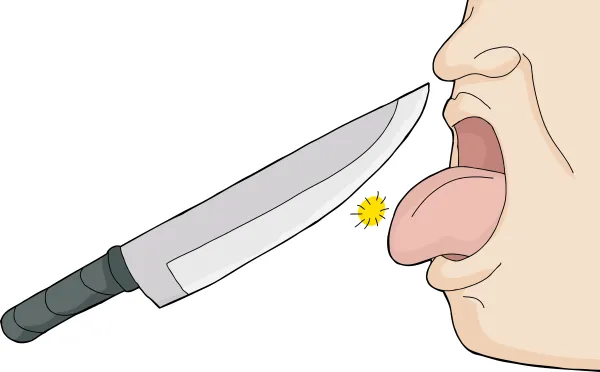
When reporting glossectomy, you will have to select an appropriate code based on the location and size of the portion of the tongue that was removed. You should also be aware of whether or not your surgeon performed other procedures during the glossectomy.
Background: Your surgeon will perform glossectomy-related procedures most often on patients with lingual cancers, such as a squamous cell carcinoma of the oral tongue. The “oral tongue” includes the anterior two-thirds of the tongue; the “base of the tongue” includes the posterior one-third of the tongue. You can include glossectomy-related codes into two groups, the first group covering diagnostic procedures (such as biopsies and lesion excisions) and the second group covering glossectomy procedures themselves.
Choose Biopsy Code Based on Location
When your surgeon performs a biopsy of a lesion of the tongue, you will need to choose from one of the two CPT® codes based on where the lesion is present on the tongue. “The site of the cancer should coordinate with the gross pathology specimen description,” says Barry Shipman, DMD, clinical professor, University of Florida School of Dentistry, Hialeah Dental Center.The portion of the tongue on which the procedure is performed distinguishes the biopsy codes from one another:
Base Lesion Excision Codes Selection on Location and Closure
The portion of the tongue on which the procedure is performed, as well as the need for closure of the wound, distinguishes the three lesion excision codes from one another:
Coding tip: If your surgeon excises a lesion of the tongue without closure, you will use 41110 irrespective of whether the lesion is in the anterior two-thirds or the posterior one-third. You will have to also look at the location of the lesion when your surgeon excises a lesion and performs closure of the surgical site. “Due to the fact that the tongue is a muscle, many anterior, or posterior lesions of the tongue can be closed primarily,” Shipman adds.
Code 41115 describes a frenectomy, in which a part or the entire midline sheath of tissue attached to the base of the tongue (known as the lingual frenum) is excised.
Example: Your oral surgeon reviews a 25-year-old male patient with complaints of a painful growth in the left margin of the tongue near the canine region. The patient says that the mass has been slowly increasing in size and has attained the current size of about 1cm in diameter and has become painful over the past month or so. Your clinician excised the lesion and sent it to the lab for biopsy. The surgical site was sutured as the lesion was located deep in the submucosal area. Since the excised lesion was in the anterior 2/3rds of the tongue and your surgeon performed closure of the surgical site, you report 41112.
Shift to Eight Other Choices for Glossectomy Procedures
When a significant portion of the tongue is removed, the procedure should be reported using one of eight glossectomy codes. Your choice of code selection will depend on the following factors:
1) The amount of tongue structure that your surgeon removed
2) Whether a neck dissection was performed or not
3) Whether or not a resection of the floor of the mouth was also performed and
4) Whether or not the mandible was resected.
The eight codes that you have to report a glossectomy procedure include:
Note: Any reconstruction that is required, such as bone, skin or mucosal grafts, may be reported separately. For example, if your surgeon performed a total glossectomy without any neck dissection and he used grafts to close the defect that is formed, you will have to report either CPT® code 20926, (Tissue grafts, other [eg, paratenon, fat, dermis]) or CPT® code 15240 (Full thickness graft, free, including direct closure of donor site, forehead, cheeks, chin, mouth, neck, axillae, genitalia, hands, and/or feet; 20 sq cm or less) in addition to the glossectomy code that you are reporting.
Check for Bundling When Reporting Glossectomy With Other Procedures
The codes 41135 and 41145 make specific reference to “unilateral” neck dissections. Sometimes, your surgeon might perform a bilateral neck dissection or lymphadenectomy. This procedure may be reported separately using 38720 (Cervical lymphadenectomy [complete]). However, you will face Correct Coding Initiative (CCI) edits if you are trying to report 38720 with these glossectomy codes. The modifier indicator for this bundling edit is ‘1’ which means you can overcome the edit by using a suitable modifier. You should append modifier 59 (Distinct procedural service) or XS (Separate structure) to 38720 to indicate that it was performed on a separate site.
The codes 41135 and 41145 cover “radical” neck dissection, a procedure that sacrifices the spinal accessory nerve, jugular vein and sternocleidomastoid muscles so the malignant lymphatic chain may be removed. Your surgeon might prefer to perform “modified radical” neck dissection whenever possible so that function of the spinal accessory nerve, jugular vein and sternocleidomastoid muscles is not jeopardized. Modified radical neck dissection is more complex than radical dissection and should not be reported using 41135 and 41145. Instead, the appropriate glossectomy code without radical neck dissection should be reported with 38724 (Cervical lymphadenectomy [modified radical neck dissection]). You will need to append modifier 59 or XS in this scenario too.
Example: A patient with a painful left tongue lesion for the past four months is found to have a 3.5-cm ulcerated lesion of the left lateral tongue and a 2.5-cm firm mass in the right mid-jugular region. The tongue lesion is biopsied and found to be a squamous cell carcinoma. Your surgeon performs a partial glossectomy and a modified radical neck dissection. You should report coded using 38724 and 41120-59.
Note: You should append modifier 59 to 41120 rather than to 38724 because it is the lesser-valued procedure in this case.
